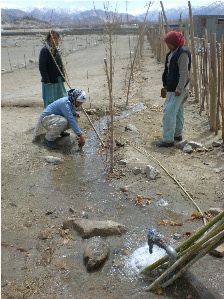
Weather patterns seem to be shifting and glaciers are tending to recede. Therefore water supply could be at risk in some areas in the medium-term.
Our solar pumps raise water from a depth of about 30 metres into above-ground reservoirs at the top of the campus, from where water is distributed under gravity through separate potable and irrigation systems. We use grey (used) water for irrigation, including for willow saplings.
We monitor the situation closely on the Shey campus and water management is becoming more and more important. This reality is being integrated into the learning process.
